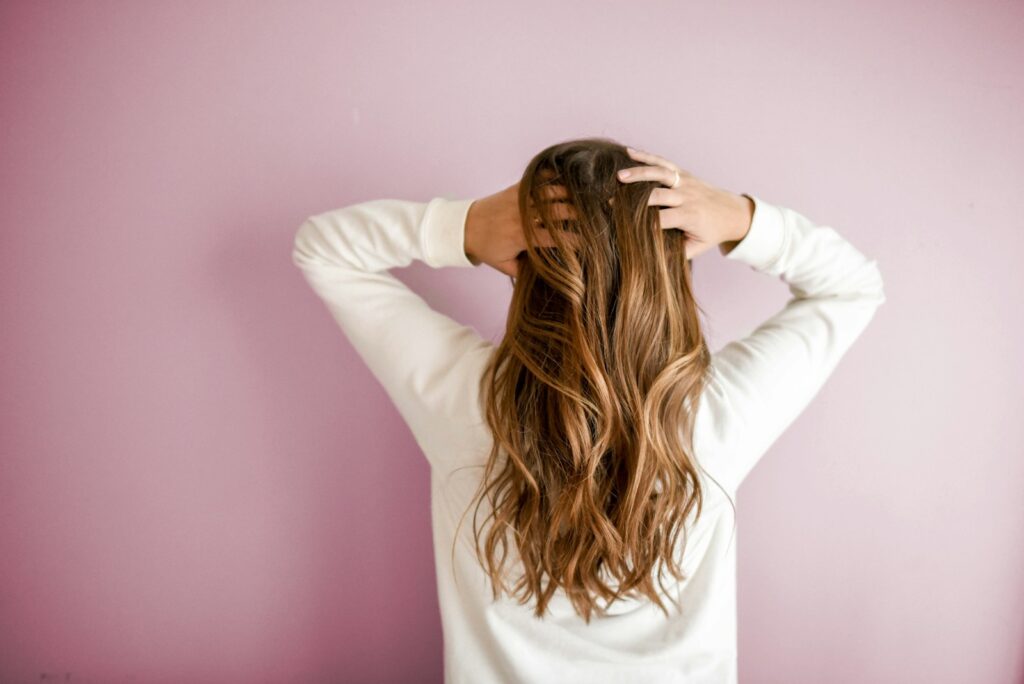
Subscribe to our newsletter
Enter your email address below and subscribe to our newsletter

During the pandemic, my social calendar screeched to a halt, which made postponing hair appointments very easy. Stories such as how actress Sarah Jessica Parker embraced her gray tresses or how pewter-haired supermodels walked the Valentino runway helped ease the slow creep of silver at my crown. Perhaps, I, too, could turn a new corner in my life. COVID presented the perfect opportunity to go natural because I could hide behind a mask as my chemically-enhanced locks grew out.
I had long rebelled against my birth color, a ho-hum brown somewhere between that of a mouse and a mushroom. Since my early twenties, I’d see-sawed between professional blonde highlights and sable lowlights, and once gray crashed the party in my late 30s, I’d been covering that, too. At age 53, three different colors now covered my head. To say nothing of my real shade, which lurked somewhere in the background. Over time, I’d grown to resent the increasing hours spent in a salon chair and since I retired, I hoped to use my time in more worthy pursuits, such as gardening, writing poetry, and enjoying a new marriage with my husband, J.P.
The sensitive sculptor and I felt lucky to have found each other by a smoldering fire pit at a Halloween cookout. Both of our previous marriages had ended, and we soon fell in love over art and literature. J.P. didn’t seem to care about things like my hair, nor my lagging right leg and the multiple sclerosis that caused it. We had been married four years, and with his support, I slowly pruned the vanities of my previous life: the fancy clothes and cosmetics I wore in an attempt to look like everyone else.
The women in my life, however, did not jump on the au naturel bandwagon.
“Gray looks good on you,” said my best friend Kelly, raising an eyebrow. “But it’s not for me.” Divorced, she had just entered the dating scene and was enjoying the attentions of a much-younger man. Jill, another friend, pledged to join me in my journey, only to renege and go even blonder than before. My mother also opposed the change. “Is it the money?” she asked. “I’ll pay for it, honey.”
Mom had been born a redhead, and now 73, had enhanced her hair all her life. In fact, she loved her synthetic shade of gilded auburn so much that when her salon ceased carrying her favorite brand of dye, she ordered it herself and toted it to her appointments.
“It’s not the money,” I said. “I’m getting tired of going to the beauty shop every five weeks.”
“Four weeks, sweetheart. You should go every four like me.” She didn’t budge, and in a trait we both share, tried to laugh off a serious subject. “Even Gracie and Roxie go to the groomers every two weeks,” she said, referring to her Maltese-poodle mixes. “They don’t complain!”
For once, I didn’t snicker. Instead, I secretly worried. Maybe it was too soon to fling myself headfirst into this strange sea of identity. What if I didn’t like the new me?
I retired early at age 49 from my job as a college admissions counselor because I wanted to ease the stress in my life, which worsened my M.S. and chronic fatigue. I had resolved to be more frugal with time and money, but my decision to give up the dye ran deeper. Although I walked without aid, my occasional stumble embarrassed me. By giving up a hair color that had never been my own, perhaps I would shed the last vestiges of my old self, and I might just begin accepting the real me, wobble and all.
Although I wasn’t sure, I had an inkling, call it a vague hope, that my unadulterated tresses laced with streaks of gray, might not be so alarming.
“I think you’re going to like the new you,” said J.P., as he ran his fingers through the hair at the nape of my neck, which I couldn’t yet see. “It sure feels a lot healthier.”
Little by little, a mixture of chestnut and lustrous silver started inching over my head. The transition was so gradual that I wasn’t shocked at all. And one year after walking away from the salon, my hair appeared to complement my skin tone in ways that the artificial tones never had. My hair now had character all its own. Even style. More importantly, I didn’t miss the nose-burning chemicals, the tugging on my head, and the hours wasted in the salon chair. For the first time in my life, I felt truly free.
I could even joke with Mom again. “We still look like sisters,” I reassured her. “But now everyone will think you’re the younger one.”
“Oh Ashie,” she said. “You’re so funny.”
As the threat of COVID waned, I shed my mask and walked boldly into the sunshine. I looked forward to uncovering even more shades of the new me, hair and all. To my great surprise, my former critics–other women my age–came around. One day a stranger in the parking lot at the grocery store shouted out: “Love the hair!”
Another one cornered me in the bookstore. “How did you get that shade?” she asked. “I mean, how much did it cost?”
“Nothing,” I told her. “Nothing at all.”
“Do you think I should do it?” She fingered her own hair, a blondish-brown that reminded me of my former tone.
“Definitely,” I told her. “Go for it.”
You took a common dilemma, that all women of a certain age nowadays encounter —-to dye or not to dye, and you fleshed it out with vivid images and funny dialogue to make the story memorable. You even have a theme: embrace the changes life inevitably sends. What a good piece of writing!